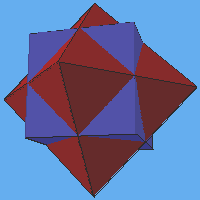Stellations of the Cuboctahedron
 The
process of stellation takes
a given polyhedron and extends its surface planes until they meet other
planes, resulting in a larger solid, a stellation of the interior solid.
This page describes the stellations of the cuboctahedron,
which is an interesting example because it is quasi-regular.
The simplest stellation (other than the "zeroth stellation" which
is the cuboctahedron itself) is the compound
of the cube and octahedron, illustrated at right. The intersection
of the cube and the octahedron is the inner cuboctahedron. (Go inside to
see it.)
The
process of stellation takes
a given polyhedron and extends its surface planes until they meet other
planes, resulting in a larger solid, a stellation of the interior solid.
This page describes the stellations of the cuboctahedron,
which is an interesting example because it is quasi-regular.
The simplest stellation (other than the "zeroth stellation" which
is the cuboctahedron itself) is the compound
of the cube and octahedron, illustrated at right. The intersection
of the cube and the octahedron is the inner cuboctahedron. (Go inside to
see it.)
Here are some other stellations of the cuboctahedron. As with other stellated polyhedra, there is no essential order for listing them, so they appear here in a no particular order:
- stellated cuboctahedron 1. This is a "dimpled" version of the stella octangula. The stella octangula comes from stellating the triangular faces of the cuboctahedron, and the dimples are carved in the planes of the square faces.
- stellated cuboctahedron 2. [44] I find this one very pleasing.
- stellated cuboctahedron 3. [45] This can be seen as six intersecting square pyramids.
- stellated cuboctahedron 4. This consists of the same six intersecting square pyramids as above, plus the stella octangula.
- stellated cuboctahedron 5. This is almost the final one.
- stellated cuboctahedron 6. [46] The final stellation.
Three of these appear in Magnus Wenninger's Polyhedron Models (see the references) along with patterns for their construction in paper. His figure numbers are given here [in square brackets].
Virtual Polyhedra, (c) 1996,George W. Hart